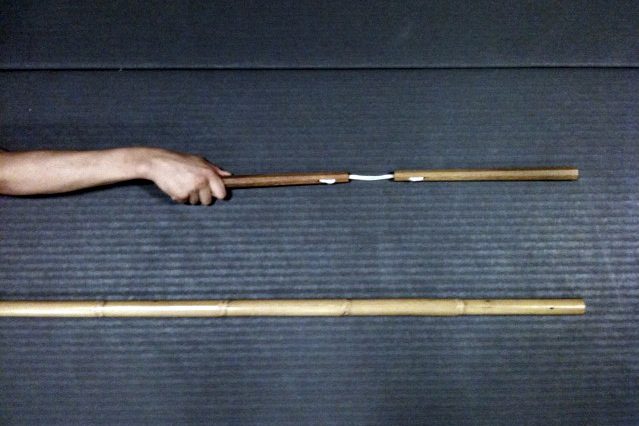A few days ago, while I was practising Kobudo, I came to think of something that happened in Okinawa 1 ½ years ago (in the summer of 2007).
Let me explain something first: Whenever we are in Okinawa, we like to train as much as possible. So if one dojo has training on for example Mondays and Wednesdays, then we go somewhere else to train on Tuesdays and Thursdays, and maybe to a third dojo on Fridays and Sundays (Saturdays are reserved for the beach!).
That is only logical. Considering the short time we are there, and the money we have spent to get there, we simply want to get the most out of the trip. Not sit and melt in our oven… Sorry I mean hotel room.
Now, over to the real topic.
One evening, training bo-jutsu in a certain Kobudo-dojo (no names), the head sensei asked what the most important finger is, when holding the bo. I’ll repeat the question:
“What is the most important finger, when holding the bo?”
Do you know?
I thought I knew. Until the sensei said the answer:
“The index finger” (the finger you point with).
I was actually surprised to hear this. Why? Because my feeling was that I would say the complete opposite (but of course I just nodded in agreement)!
I think the index finger is maybe the least important finger, when holding the bo. And anyone who has ever trained any form of grappling/seizing/controlling/restraint-techniques should agree with this, because the most important fingers when grappling are the last three fingers (mainly due to the fact that they share the same flexor muscle). We’re not counting the thumb here.
But what has grappling got to do with holding a bo, you may think? Well, since you are holding the bo, I think the same principle would apply, whether it’s a bo, lapel or an arm you are holding! Holding something doesn’t come in that many variations, since the body functions in almost the same way when you hold something, regardless of the objects form, or function.
To prove my point, I will now give you some examples of other martial arts (that specialize in grappling) that consider the index finger almost useless.
1. Gracie Jiu-jitsu. Sure, they can’t spell Ju-jutsu correct, but they can grapple. Who hasn’t heard of the Gracies? And in Gracie Jiu-jitsu the non use of the index finger is a prominent feature.
2. Hakko-ryu Jujutsu. An old Japanese traditional school of Jujutsu. A great style, that lacks something: The use of the index finger. As does most other traditional Jujutsu schools that I know of.
3. Aikido. One of the most widely spread Japanese martial arts. And they always emphasize having the index finger free when holding/throwing. For example in the technique yonkyo (see picture to the right).
4. Judo. Let me just quote a famous Judo-book, that mentions something about gripping with the last three fingers, and what beginners think of it:
“Beginners are apt to discard this type of gripping as weak or impossible to perform, but with subsequent practice, it will be proven that this method allows the quickness of movement, fullest flexibility of the wrists, and best control of the opponent essential to sound technique.”
– Ishikawa, T. Draeger, D. (1999). Training Advice. Judo Training Methods, 77-78:
This was just some examples, there are many more styles, (Chinese too), that swear by using the last three fingers for gripping. And this is what I myself had discovered, and that’s why I was so surprised when this sensei mentioned the index finger as being the most important.
But maybe he just had a bad day?
So, what have I been trying to say with this post? Let’s sum it up:
1. The index finger is not the most important finger in Aikido, Judo, Jujutsu or other grappling styles. And not in Kobudo either. If you still don’t believe me, then train… and you will see the light too.
2. Just because someone is Japanese, has a high degree and nice lineage, doesn’t necessarily make them right. “Even monkeys fall from trees”. At least if they only use their index finger…
By the way: Before I stop I just wanted to show you this picture of Funakoshi Gichin (founder of Shotokan-ryu), holding a bo. Can you see anything special about his top hand?
I’ll give you an ice cream if you see it.




17 Comments